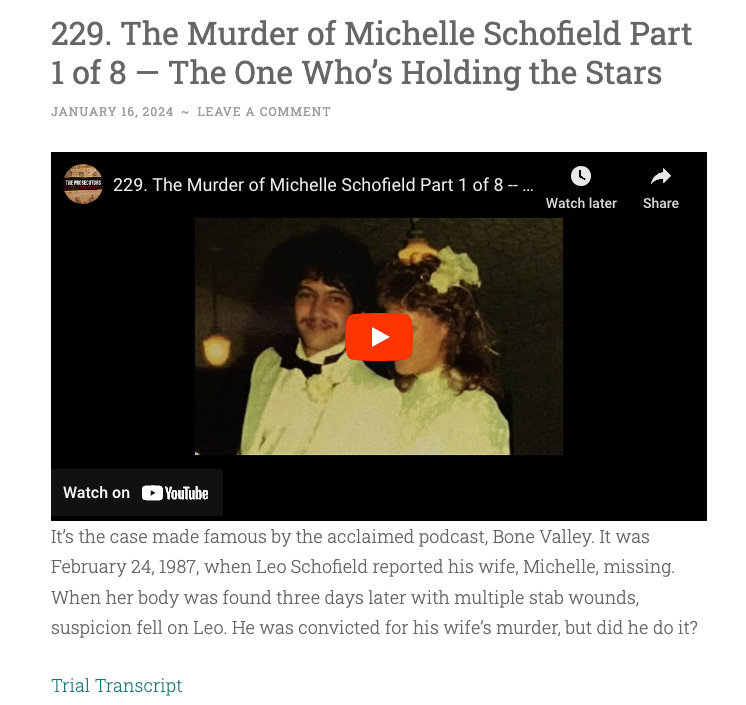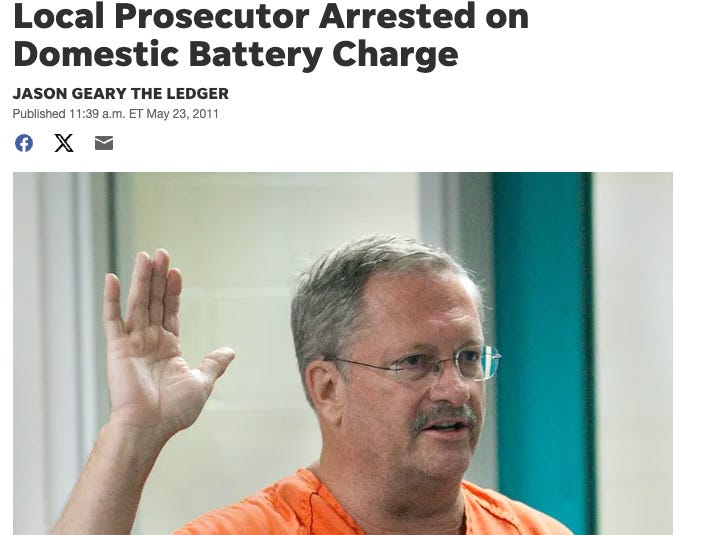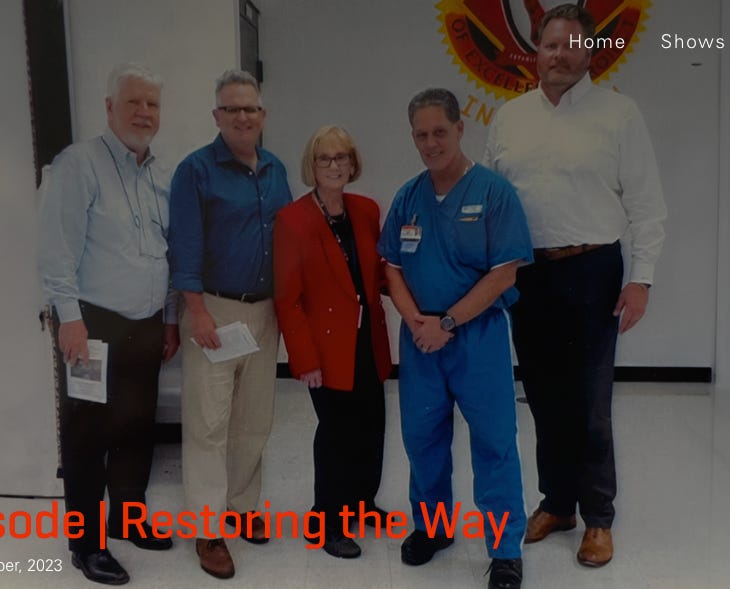"The Prosecutors" podcast puts the Schofield prosecution and its vibes under professional scrutiny
The first episode (of eight) breaks down the timeline on the night of Michelle Schofield murder in an incredibly useful way. The "vibes" that convicted Leo Schofield seem headed for a thorough review.
Listen to the first Leo Schofield episode here.
Listen here to the introductory episode of the podcast which provides excellent context on “The Prosecutors” — who are actual former and current prosecutors — and their background and overall approach.
The state of Florida has long resisted calls from Leo Schofeld’s supporters to submit his case to a formal “conviction integrity review” process through an independent agency. This podcast may well prove to be the next best-thing by subjecting John Aguero and Victoria Avalon and Jerry Hill to the scrutiny of professional peers.
The vibe conviction meets an independent peer review
When you read the 1989 trial transcripts, especially the closing arguments, it’s clear that Leo Schofield was convicted on vibes — on inferences about violence against his wife Michelle that he could have perpetrated, based on his character and behavior as a very young husband in a marriage that shouldn’t have existed.
Here’s what Leo Schofield could have done; so he must have done it. Who else could have? We have no actual evidence that he did this specific crime; but you have to believe sooooo many coincidences, mostly about what a lousy husband Leo is, to think he didn’t do it.
That was the prosecution’s trial narrative, which was weak and substanceless long before Jeremy Scott entered the picture years later with direct physical evidence and his various confessions.
But this who else? vibe hung on Leo Scholfield succeeded thoroughly by inverting the burden of proof. Over and over again, Prosecutor John Aguero emotionally hammered all the ways in which Leo did not prove his innocence beyond and to the exclusion of a reasonable doubt. Thus, any doubt about Leo’s innocence became sufficient for the jury to convict.
Of course, that is not how a murder trial — or any trial — is supposed to work.
That’s why it’s exciting to hear actual prosecutors, who are skeptical of vibes, which are more often a tool of the defense in creating reasonable doubt, begin to address the Schofield vibes from a professional, not personal or even moral, point-of-view.
In their first Schofield episode, “The Prosecutors” don’t even take a position on Leo’s guilt other than a baseline assumption that he did it because he was convicted as a starting point. Then they just factually build out the timeline of the night of the murder, what’s known and what’s not known — and what the state’s theory of the case requires.
I found this process revelatory — in part because the scope of storytelling of Bone Valley and sheer volume of records in the case are so massive. A narrower focus on the merits of the case is extremely helpful in understanding how vibes convicted Leo in 1989.
Most focus in recent years on the Schofield case — my own included — has revolved around Jeremy Scott, the emotionally-damaged rapist and convicted killer who left fingerprints on Michelle’s car and later confessed in escalating detail to murdering Michelle.
But “The Prosecutors,” just by coolly laying out timeline facts in an easy to understand way, show how weak, non-sensical, and vibe-dependent the case always was against Leo Schofield, years before Jeremy Scott ever entered the picture.
“The Prosecutors:” a professional, not journalistic, lens
I would urge you to listen to the introductory episode of “The Prosecutors” to get a sense of their own vibe and background. These folks are not some “Soros prosecutor” fantasy.
They are confident that Adnan Syed of Serial fame is guilty, for instance. (I’ve never listened to that story and have no opinion.)
I found their 10 guidelines for approaching cases extremely useful for understanding their points-of-view. Each of these general principles, I think, will also find fertile ground for exploration in the Schofield case.
The simplest answer is the most likely to be correct.
If there is no evidence of a crime, there probably wasn’t a crime.
Usually, law enforcement can be trusted.
Conspiracies are hard to pull off and even harder to keep secret.
Do not mistake incompetence for malice.
There will never be a theory that answers all the questions or addresses all the evidence.
We never know all the facts.
The most obvious suspect is usually the one who did it.
People lie, but that doesn’t make them liars.
BUT in extraordinary cases, expect the extraordinary. Cause what’s the point of rules if you can’t break them?
I very much look forward to “The Prosecutors” applying these principles to some of the core arguments and behavior displayed during the trial — even before they get to the egregious refusal to retry Leo Schofield with all the available evidence that emerged afterward.
John Aguero’s blatant lie to the jury and other vibes to interrogate
Here are a few direct quotes from lawyers in the trial that provide excellent opportunities for review with “The Prosecutors.” Some are specifically important; and others representative of the fatal, unfilled holes in the case.
This is a circumstantial case. I hope you didn’t expect Leo Schofield to get on the stand and break down and admit he did it. This isn’t Perry Mason. This is a case where this man set up an alibi with his parents, took a great deal of effort doing so, and he wants to try and buffalo you ten people. He wants you to go back there and believe that there’s some psycho running around out there killing people that he doesn’t rape or rob and leaving their bodies in canals.
— From John Aguero’s closing argument. At this precise moment, in 1989, fingerprints from Jeremy Scott are on Michelle’s abandoned car; but no one in law enforcement has identified them. Scott would qualify as a “psycho” serial killer “out there killing people” in Aguero’s loose parlance. Scott, who Aguero himself convicted of murder, has since confessed to Michelle’s Schofield’s murder multiple times in escalating detail.
Wouldn't you like to know, for example, if someone else's fingerprints were in that truck or in that Mazda, in that stationwagon? The State of Florida didn't bother to dust that wagon and try to get any fingerprints out of that wagon.
— Jack Edmund, Leo Schofield’s defense lawyer, during his closing argument. Indeed, wouldn’t a jury want to know that “psycho” killer Jeremy Scott’s prints were on Michelle’s car? How would that have changed Aguero’s already weak, vibe-dependent case?
Now, what happens with Alice Scott? She hears somebody screaming. Now, ladies and gentlemen, you go back in that jury room and you let one of your members scream ahhhh, don’t do that, no, no, Leo, don't stab me, no, leave me alone, no.
— John Aguero, openly lying to the jury by quoting testimony that does not exist during his closing. No one ever came close to testifying that they heard Michelle Schofield scream: “ahhhh, don’t do that, no, no, Leo, don't stab me, no, leave me alone, no.” Aguero invented it out of whole cloth. If he were still alive, and the statute of limitations hadn’t run out, I would file a bar complaint against Aguero for the exact same “candor toward the tribunal” violations I’ve alleged against his long-time boss Jerry Hill. I wish I could file one posthumously.
And Leo Schofield, according to the state attorney, is so violent that he’s never been arrested, he’s never had a fight, he’s never been in trouble with the law.
— Jack Edmund again, in his closing statement, responding to witness testimony that Leo was an abusive, sometimes violent husband.
It is a dark factual oddity of this case — a vibe — that the prosecutor most responsible for the injustice against Leo — and who most intensely portrayed him as a monstrous purveyor of domestic violence — had a personal domestic violence arrest record. Leo Schofield does not, other than his murder conviction. John Aguero is dead now; but it doesn’t change the record.
Professional inventory vs. moral inventory
Bone Valley also recently released an excellent, brief episode updating Leo’s experience in the inmate transition program that is preparatory to his release on parole, which his supporters hope will happen within months.
Leo describes his early difficulty in a program literally built to help guilty inmates transition back to society. Owning that guilt and accounting for it is a cornerstone of the program. This from Leo comes at about 20:30 of the episode:
I will say that what CTP has helped me, what my brothers have helped me with here — that was different than any other place before — is that I’ve been able to take a really strong moral inventory of my own life and the reason why I’m here.
I’m very careful about how I word this because I’m not guilty. Having said that, my life before this crime had taken place was pretty rocky because of my personality issues and growing up and just the attitude I had. And that played as much a part in allowing people, like on the jury, to believe that I was guilty as anything else. So I had to take accountability for my own actions.
Vibes.
Here is Leo Schofield taking responsibility in public for own vibes with a “strong moral inventory.”
Not one single person in the machinery of law enforcement or the courts, not one single person who had a role in this vibe-based atrocity of justice, has ever made any effort to take a strong moral inventory of their actions. Not a prosecutor, not a judge, not a politician. They have protected themselves and their personal and professional benefactors at every turn. It is morally despicable.
If they’re all too afraid or vain to account for their moral behavior, maybe the disinterested peer review of fellow prosecutors will bring professional accountability at long last.







